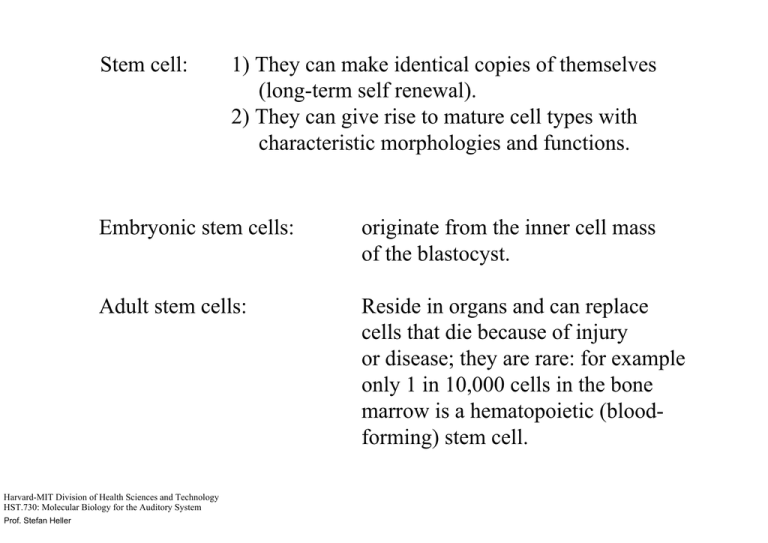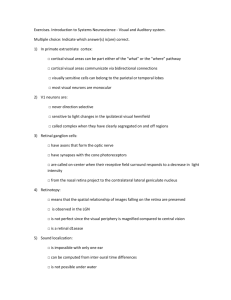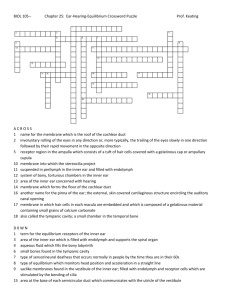Stem cell: 1) They can make identical copies of themselves
advertisement

Stem cell: Embryonic stem cells: originate from the inner cell mass of the blastocyst. Adult stem cells: Reside in organs and can replace cells that die because of injury or disease; they are rare: for example only 1 in 10,000 cells in the bone marrow is a hematopoietic (bloodforming) stem cell. Harvard-MIT Division of Health Sciences and Technology HST.730: Molecular Biology for the Auditory System Prof. Stefan Heller 1) They can make identical copies of themselves (long-term self renewal). 2) They can give rise to mature cell types with characteristic morphologies and functions. Embryonic stem cells (ES cells) Stem cells The naïve goal Mimic ear development Hair cells • easy to get • easy to maintain • a long way from ES cell to hair cell Inner ear stem cells? Adult stem cells Progenitor cells Hair cells A permanent source for adult stem cells: Adult stem cells from the skin Inner ear progenitor cells Hair cells Embryonic development: Ectoderm Marker genes can reveal cell types Otic placode Otic vesicle Sensory patches hair cells Collection of inner ear marker genes MARKER GENE Otx2 Pax2 Sox3 BMP4, BMP7 Hmx3 Nkx5-1, Nkx5-2 Sox10 Math1 Notch1 Delta1 Jagged1 Jagged2 Brn3.1 Pv3 Myo VIIA Espin AchR D9, D10 Mehc1 Tmc1 Cx26 TectA Coch Pax6 Nestin NCAM GAPDH EXPRESSION undifferentiated ES cells, neuroectoderm, otic vesicle otic placode, developing midbrain, hindbrain, and eye otic placode otic placode, otic vesicle developing vestibular inner ear developing inner ear non-sensory epithelia, nascent stria vascularis otic vesicle, developing inner ear sensory epithelia, supporting cells developing inner ear sensory epithelia otic vesicle, developing inner ear sensory epithelia developing inner ear sensory epithelia, nascent hair cells developing inner ear sensory epithelia, supporting cells developing inner ear sensory epithelia developing inner ear sensory epithelia, mature hair cells early hair cells, mature hair cells otic vesicle, olfactory epithelium, retina, hair cells hair cells, Sertoli cells cochlear and vestibular hair cells inner hair cells, mature photoreceptor cells hair cells inner ear non-sensory cells, skin developing inner ear inner ear fibrocytes developing eye, developing central nervous system Neuronal progenitors Neuronal progenitors ubiquitously expressed housekeeping gene early markers late markers Embryonic development: Ectoderm Marker genes can reveal cell types Otic placode Otic vesicle Sensory patches hair cells ES cells Embryoid bodies (Ectoderm, Endoderm, Mesoderm) Embryonic development: Ectoderm Marker genes can reveal cell types Otic placode Otic vesicle Embryoid bodies (Ectoderm, Endoderm, Mesoderm) Factors that promote selective survival of otic progenitors Cell types of the otic placode: cells that express placode markers Sensory patches hair cells Myosin VIIA Pv3 F-actin What is next: a) b) c) d) Are the hair cell-like cells really hair cells? Are these cells able to integrate into a developing ear? Are these cells able to integrate into an injured ear? Can we “heal” a deaf mouse with these cells? Inner ear stem cells? Adult stem cells Progenitor cells Hair cells Are there adult stem cells in the inner ear? • Hair cell regeneration happens to a small degree in the mouse utricle (Forge et al., 1993, Science 259) Principal strategy Mouse utricle Low density single cell culture In neural stem cell world, this would be called a neurosphere Sphere formation Selection of progenitor cells Hair cells and supporting cells by in vitro differentiation Immunostaining for the progenitor cell marker nestin in neural stem cells (C) and in inner ear spheres (D) Myosin VIIA What is next: a) b) c) d) e) Are the hair cell-like cells really hair cells? Are these cells able to integrate into a developing ear? Are these cells able to integrate into an injured ear? Can we “heal” a deaf mouse with these cells? Can we generate other cell types as well? For example auditory neurons: Do these neurons (re-)innervate a cochlea? Elimination of the auditory ganglion with a neurotoxin followed by “repair” with progenitor cells selected from ES or adult stem cells. A) TypeII collagen B) TypeII collagen after elimination C) Homogenin after elimination D) Coch after elimination => No change in other cell types. Further Reading From Groves and Bronner-Fraser, 2000




